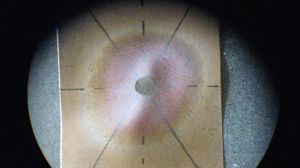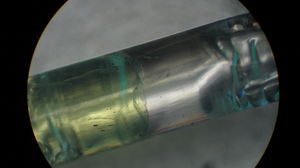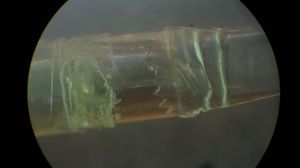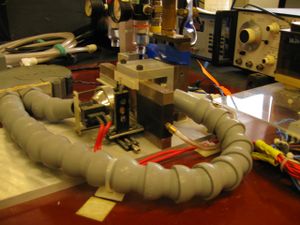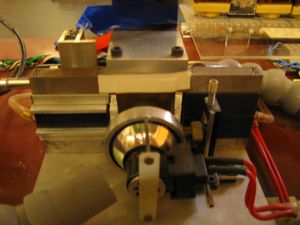Difference between revisions of "Pratt/splicer"
Jump to navigation
Jump to search
(Created page with '*The polystyrene optical fiber splicer was originally designed by Michigan State University mechanical design specialist Ron Richards. Created originally for the Gem experiment a…') |
|||
| (3 intermediate revisions by the same user not shown) | |||
| Line 1: | Line 1: | ||
*The polystyrene optical fiber splicer was originally designed by Michigan State University mechanical design specialist Ron Richards. Created originally for the Gem experiment at Fermi Lab (1) as well as D0(2) it continues to be the benchmark design for fusing plastic fibers. Essentially, the fibers to be joined are placed in a vacuum vice and pushed together with preset pressure. The ends of the fibers are held in place with two V groove glass ferrules and fused together from a collimated projector bulb. During the welding process, turbulent cold air is directed at the ferrule to keep the outer cladding from "singing". We have received a complete setup from MSU and have only slight modifications to make before it can be used. Currently, the splicer is setup for round fibers of very small diameter (<0.5mm) and we must procure a glass ferrule that will accommodate our 2x2mm square fibers. We are in contact with Wilmad Lab Glass of NJ to develop such ferrules with extremely high precision. It would also be extremely advantageous for our group to be able to produce our own glass ferrules and we are currently exploring this option. | *The polystyrene optical fiber splicer was originally designed by Michigan State University mechanical design specialist Ron Richards. Created originally for the Gem experiment at Fermi Lab (1) as well as D0(2) it continues to be the benchmark design for fusing plastic fibers. Essentially, the fibers to be joined are placed in a vacuum vice and pushed together with preset pressure. The ends of the fibers are held in place with two V groove glass ferrules and fused together from a collimated projector bulb. During the welding process, turbulent cold air is directed at the ferrule to keep the outer cladding from "singing". We have received a complete setup from MSU and have only slight modifications to make before it can be used. Currently, the splicer is setup for round fibers of very small diameter (<0.5mm) and we must procure a glass ferrule that will accommodate our 2x2mm square fibers. We are in contact with Wilmad Lab Glass of NJ to develop such ferrules with extremely high precision. It would also be extremely advantageous for our group to be able to produce our own glass ferrules and we are currently exploring this option. | ||
| − | + | *[http://lss.fnal.gov/archive/other/ssc/ssc-gem-tn-93-305.pdf] | |
| − | + | *[http://d0server1.fnal.gov/users/strang/web/fpd/detector/c_detector.html#mile2] | |
| + | {| cellpadding="3" style="text-align:center; margin: 1em auto 1em auto" | ||
| + | |- | ||
| + | |[[File:silfos_alighnment.jpg|left|thumb]]|| || [[File:fused_joint.jpg|left|thumb]]|| || [[File:fused_cladding.jpg|left|thumb]]|| || [[File:msu_splicer.jpg|left|thumb]]|| || [[File:msu_splicerII.jpg|left|thumb]] | ||
| + | |- | ||
| + | |} | ||
Latest revision as of 20:32, 26 January 2010
- The polystyrene optical fiber splicer was originally designed by Michigan State University mechanical design specialist Ron Richards. Created originally for the Gem experiment at Fermi Lab (1) as well as D0(2) it continues to be the benchmark design for fusing plastic fibers. Essentially, the fibers to be joined are placed in a vacuum vice and pushed together with preset pressure. The ends of the fibers are held in place with two V groove glass ferrules and fused together from a collimated projector bulb. During the welding process, turbulent cold air is directed at the ferrule to keep the outer cladding from "singing". We have received a complete setup from MSU and have only slight modifications to make before it can be used. Currently, the splicer is setup for round fibers of very small diameter (<0.5mm) and we must procure a glass ferrule that will accommodate our 2x2mm square fibers. We are in contact with Wilmad Lab Glass of NJ to develop such ferrules with extremely high precision. It would also be extremely advantageous for our group to be able to produce our own glass ferrules and we are currently exploring this option.
- [1]
- [2]
